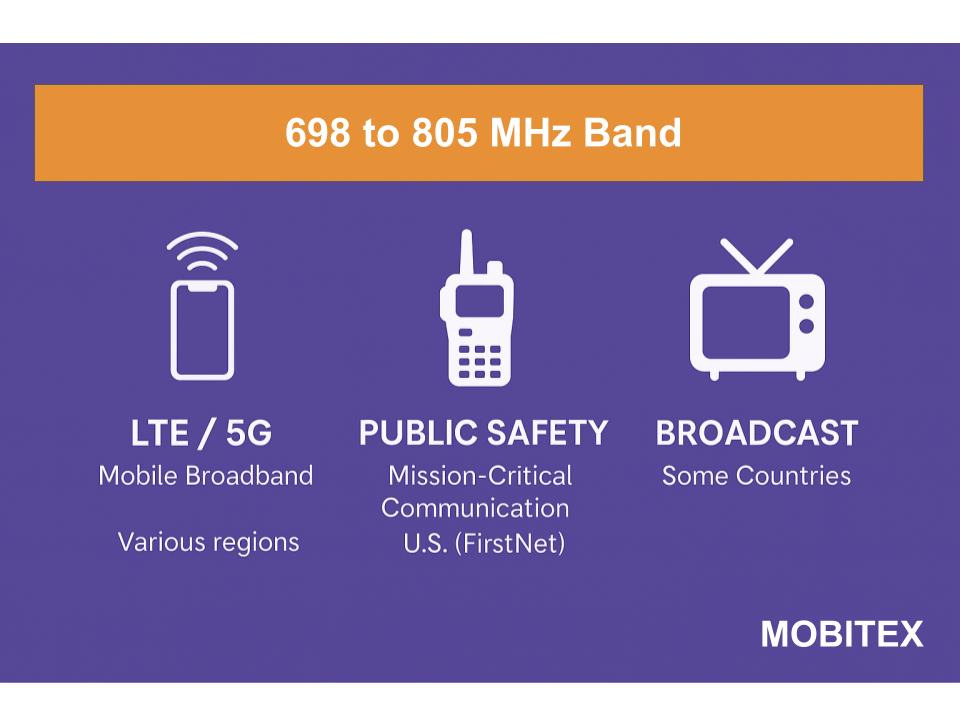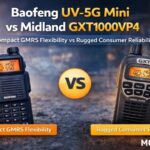Frequency
805 MHz
Range
698–806 MHz
Band Group
UHF (300–1000 MHz)
🌐 Summary
The 805 MHz allocation is part of the UHF (300–1000 MHz) spectrum. This range is used worldwide for critical applications that keep our communications and infrastructure running smoothly. On this page we highlight how each band is applied in real systems, from regulatory assignments to everyday devices. Our goal is to make spectrum data clear and practical for engineers, regulators, and enthusiasts alike.
Key uses of this band include: 805 MHz: LTE/5G low-band coverage, NB-IoT; First responder/public safety blocks in some countries; Mobile, Fixed; Smartphones, LTE/5G base stations, CPEs.
Upper edge of 700 MHz public-safety narrowband; above 806 MHz begins 800 MHz LMR bands (e.g., 806–824/851–869).

🔍 Explore the full RF Spectrum database
📡 Band & Geometry key
| Field | Value |
|---|---|
| Wavelength (m) | 0.373 |
| Waveforms | LTE, 5G NR; NB-IoT/LTE-M |
| Antenna Form Factor (Typical) | ¼-wave ≈ 9.32 cm |
| Band Family | IMT/Cellular |
| Band | 700/800 MHz Mobile (IMT) + Public Safety |
| Primary Common Name | Mobile (IMT), Public safety (regional), Guard bands |
| FSPL @ 1 km [dB] | 90.555917607357 |
| FSPL @ 10 km [dB] | 110.55591760736 |
| Fresnel Radius @ 1 km (m) | 9.6520586418051 |
| Band Group | UHF (300–1000 MHz) |
| Tax Band Family | UHF |
| Tax Band Class | 700/800 MHz Mobile & Public Safety (698–806) |
🧩 Applications & Usage
| Field | Value |
|---|---|
| Primary Application | LTE/5G low-band coverage, NB-IoT; First responder/public safety blocks in some countries |
| Lower Neighbor Use | UHF TV / Mobile broadband (digital dividend) |
| Upper Neighbor Use | 800 MHz Public Safety / SMR (UL) + start of Cellular UL |
| Typical Services Devices | – |
| Market Common Devices | Smartphones, LTE/5G base stations, CPEs |
| Refarming Use | No |
| Device Ecosystem Size | High (>1000 models) |
| Device Hotspots (MHz) | 835, 845, 880 |
| Device Category | Cellular Handsets / Modems (legacy) |
| Typical Use Cases | – |
| Modulation (Device) | GSM (200 kHz), CDMA/AMPS (legacy) |
| Channel Width (Device) [kHz] | 200 |
| Device Region Profiles | Cellular 850 legacy in many countries |
| Per-Region EIRP Or Duty (Device) | Network- and band-class specific; handhelds ~23 dBm |
| Allocation Relevance (Device) | Medium (legacy cellular) |
| Adjacent-Band Collision Risks (Device) | Moderate: cellular band edges |
| Example Devices Or Skus | Cellular (2G/3G Legacy Devices) |
| Common Protocols | LTE; 5G NR; GSM/EDGE; UMTS (legacy); Analog FM (12.5 kHz); DMR; P25 (region); TETRA (region) |
🗒️ Notes
| Field | Value |
|---|---|
| Receiver Selectivity Notes | – |
| Interference Notes | – |
| Compatibility Risk Notes | – |
| Notes | Upper edge of 700 MHz public-safety narrowband; above 806 MHz begins 800 MHz LMR bands (e.g., 806–824/851–869). |
| Propagation Notes | Strong coverage, good indoor penetration |
⚙️ Technical Rules
| Field | Value |
|---|---|
| Lower Band Frequency Limit | 698 |
| Upper Band Frequency Limit | 806 |
| EIRP Indoor Limits | N/A (licensed; verify national rules) |
| EIRP Outdoor Limits | N/A (licensed; verify national rules) |
| PSD Limit | — |
| Emission Mask Class | Generic (planning) |
| Guardband Minimum [kHz] | 100 |
| Typical Bandwidths | 5, 10, 20 MHz |
| Autocalculated Bandlimits | No |
| Typical Bandwidths (Estimated) | 5, 10, 20 MHz |
| Max EIRP [dBm] | Network- and band-class specific; handhelds ~23 dBm |
| Power Source Or Duty Profile (Typical) | – |
| Channelization Plan | 5, 10, 20 MHz |
| Channelization | LTE/NR blocks (5–20 MHz typical) |
| Guard Band Requirement | 1–5 MHz typical |
| OOB Emission Limit [dBm/MHz] | -13 (baseline) |
| Spurious Emission Limit (dBm) | -30 (baseline) |
| RX Blocking Min [dBm] | -15 (planning) |
| Duplexing | FDD (APT 700, US 700 variants); some guard bands |
| Duplexing Information | FDD: APT 700: 703–748 MHz UL; US 700 includes UL blocks at 699–716 & 777–798 MHz uplink / APT 700: 758–803 MHz DL; US 700 includes DL blocks at 729–746, 746–756, 758–768 MHz downlink |
| Uplink Pairing | APT 700: 703–748 MHz UL; US 700 includes UL blocks at 699–716 & 777–798 MHz |
| Downlink Pairing | APT 700: 758–803 MHz DL; US 700 includes DL blocks at 729–746, 746–756, 758–768 MHz |
| Paired Band Info | Band 20 (EU 800): 832.0-862.0 MHz ↔ 791.0-821.0 MHz |
| Max EIRP [dBm] | UE: 23 dBm, BS: up to 64 dBm |
| Channelization Block Size | – |
| 3GPP Band Number | |
| Example 3GPP Bands | Band 20 (n20) DL (EU) |
| LTE Uplink Bands | – |
| LTE Downlink Bands | Band 20 |
| NR Uplink Bands | – |
| NR Downlink Bands | n20 |
| Guard Bands | – |
| Protocol Or Standard | – |
🌎 Country Overrides
| Field | Value |
|---|---|
| Tax Service Category | Other / Various |
| Tax License Type | Licensed (Exclusive / Auctioned) |
| Tax Regions | Global / Varies |
| ITU Region 1 | Mobile, Fixed |
| ITU Region 2 | Mobile, Fixed |
| ITU Region 3 | Mobile, Fixed |
| License Type | Licensed IMT/mobile broadband; public safety allocations (regional) |
| Primary Application | LTE/5G low-band coverage, NB-IoT; First responder/public safety blocks in some countries |
| Primary Services | Mobile, Fixed |
| Spurious Emission [dBm] | -30 (baseline) |
| Lower Neighbor Use | UHF TV / Mobile broadband (digital dividend) |
| Upper Neighbor Use | 800 MHz Public Safety / SMR (UL) + start of Cellular UL |
| Licensing Model | – |
| Typical Services Devices | – |
| US FCC Alloc | -– |
| CA IC Alloc | -– |
| UK Ofcom Alloc | -– |
| US Ref | – |
| Typical Bandwidths | 5, 10, 20 MHz |
| Market Licensing Model | Exclusive Licensed |
| Market Common Devices | Smartphones, LTE/5G base stations, CPEs |
| Fresnel Radius (1st, 1 km) [m] | 9.6520586418051 |
| Typical Bandwidths (Estimated) | 5, 10, 20 MHz |
| Auction Status | Auctioned |
| Refarming Use | No |
| Typical Site Spacing km | 2 / 8 |
| Device Ecosystem Size | High (>1000 models) |
| Traffic Load Share | Coverage-heavy, low capacity share |
| Device Hotspots (MHz) | 835, 845, 880 |
| Device Category | Cellular Handsets / Modems (legacy) |
| Typical Use Cases | – |
| Typical Center Frequencies [MHz] | – |
| Rule Part (Fcc Or Region) | – |
| Modulation (Device) | GSM (200 kHz), CDMA/AMPS (legacy) |
| Channel Width (Device) [kHz] | 200 |
| Device Region Profiles | Cellular 850 legacy in many countries |
| Per-Region EIRP Or Duty (Device) | Network- and band-class specific; handhelds ~23 dBm |
| Allocation Relevance (Device) | Medium (legacy cellular) |
| Adjacent-Band Collision Risks (Device) | Moderate: cellular band edges |
| Example Devices Or Skus | Cellular (2G/3G Legacy Devices) |
| Antenna Form Factor (Typical) | ¼-wave ≈ 9.32 cm |
| Power Source Or Duty Profile (Typical) | – |
🛡️ Regulatory & Neighbors
| Field | Value |
|---|---|
| Lower Band Frequency Limit | 698 |
| Upper Band Frequency Limit | 806 |
| Rx Blocking Min dBm | -15 (planning) |
| Lower Neighbor Use | UHF TV / Mobile broadband (digital dividend) |
| Upper Neighbor Use | 800 MHz Public Safety / SMR (UL) + start of Cellular UL |
| Lower Neighbor Band | UHF TV / Mobile broadband (digital dividend) |
| Lower Neighbor Range | 601.000–698.000 MHz |
| Upper Neighbor Label | 800 MHz Public Safety / SMR (UL) + start of Cellular UL |
| Upper Neighbor Range | 807.000–826.000 MHz |
| Adjacent-Band Collision Risks (Device) | Moderate: cellular band edges |
| Real-World Range (Indoor/Outdoor) | – |
| US FCC Alloc | — |
| CA IC Alloc | — |
| UK Ofcom Alloc | — |
| Regulatory References | US: -; CA: -; UK: – |
| Global Harmonization | Global |
| Crossborder Coordination | High |
| Sharing Mechanism | Exclusive licensed |
| Auction Status | Auctioned |
| Guard Or Pair | APT 700 duplex gap 748–758 MHz; US guard bands vary |
📈 Market & Measurements
| Field | Value |
|---|---|
| Noise Floor | Low-to-moderate (wide-area coverage) |
| Interference Cases | Adjacent TV/IMT coexistence; cross-border coordination |
| Lower Neighbor Range | 601.000–698.000 MHz |
| Upper Neighbor Range | 807.000–826.000 MHz |
| Interference Notes | – |
| Market Licensing Model | Exclusive Licensed |
| Market Commercial Value | High |
| Market Common Devices | Smartphones, LTE/5G base stations, CPEs |
| Market Deployment Density | High |
| Noise Floor (Estimated) | Low-to-moderate (wide-area coverage) |
| Market Commercial Value (Estimated) | High |
| Ecosystem Maturity | Mature |
| Indoor Penetration | Good |
| Known Interference | Broadcast to IMT coexistence issues |
| Device Ecosystem Size | High (>1000 models) |
| Real-World Range (Indoor/Outdoor) | – |
| Antenna Form Factor (Typical) | ¼-wave ≈ 9.32 cm |
| Ecosystem Maturity | Mature |
| Device Ecosystem Size | High (>1000 models) |
| Chipset Availability | Qualcomm, MediaTek, HiSilicon |
| Operator Deployments | Global Tier-1 operators |
| Technology Generations Deployed | 4G LTE |
| Roaming Support | Yes |
| Traffic Load Share | Coverage-heavy, low capacity share |
| Indoor Penetration | Good |
| Known Interference | Broadcast to IMT coexistence issues |
| Occupancy | High in mobile markets |
| Occupancy Bucket Pct | 10–30% |
| Latency Profile | <10 ms |
| Common Channels Or Profiles | – |
| Security Features | – |
| Lbt Or Fhss Requirement | – |
| Popularity (Installed Base) | – |
| Coexistence Tips | – |
| Latency Class | – |
| Device Hotspots (Scoped && Tagged) | – |
